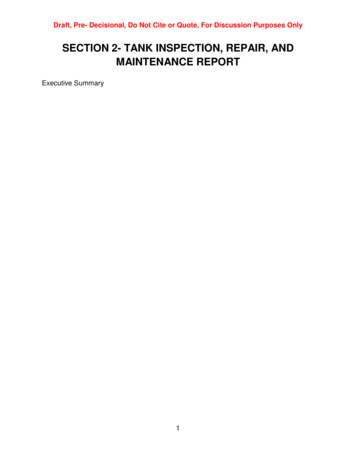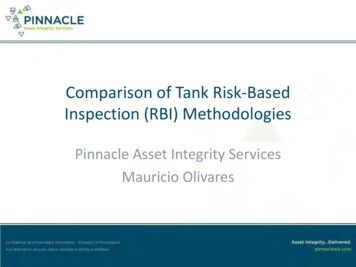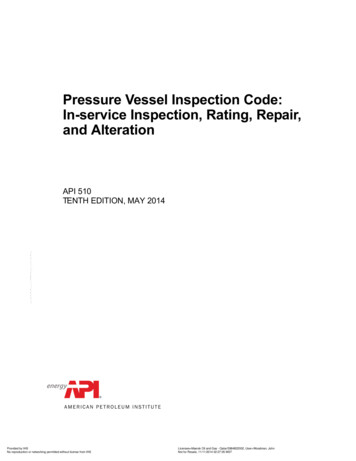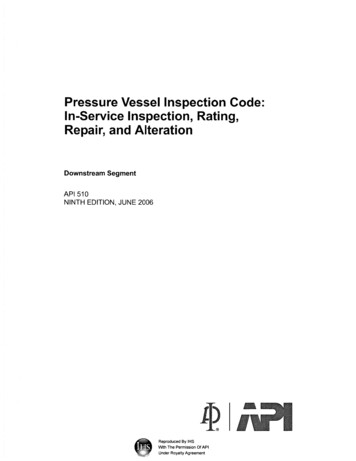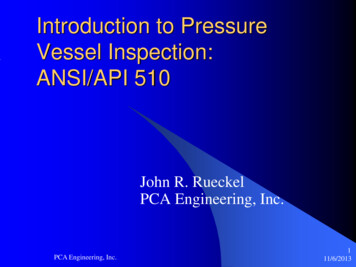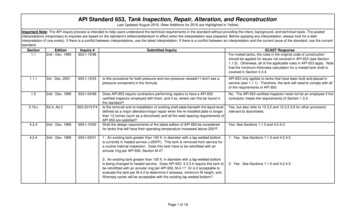
Transcription
API Standard 653, Tank Inspection, Repair, Alteration, and ReconstructionLast Updated August 2016. (New Additions for 2016 are Highlighted in Yellow)Important Note: The API inquiry process is intended to help users understand the technical requirements in the standard without providing the intent, background, and technical basis. The postedinterpretations (responses) to inquiries are based on the standard’s edition/addendum in effect when the interpretation was prepared. Before applying any interpretation, always look for a laterinterpretation (if one exists). If there is a conflict between interpretations, use the latest interpretation. If there is a conflict between an interpretation and the current issue of the standard, use the currentstandard.SectionEditionInquiry #Submitted InquirySCAST Response1.12nd - Dec. 1995653-I-10/98For riveted tanks, the rules in the original code of constructionshould be applied for issues not covered in API 653 (see Section1.1.5). Otherwise, all of the applicable rules in API 653 apply. Notethat the minimum thickness calculation for a riveted tank shell iscovered in Section 4.3.4.1.1.13rd - Dec. 2001653-I-12/03Is this procedure for both pressure and non-pressure vessels? I don’t see apressure component in the formula.API 653 only applies to tanks that have been built and placed inservice (see 1.1.1). Therefore, the tank will need to comply with allof the requirements of API 650.1.52nd - Dec. 1995653-I-04/99Does API 653 require contractors performing repairs to have a API 653certified inspector employed with them, and if so, where can this be found inthe standard?Is the removal and re-installation of existing shell plate beneath the liquid leveldefined as a major alteration/major repair when the re-installed plate is longerthan 12 inches (such as a doorsheet) and all the weld spacing requirements ofAPI 653 are satisfied?Shall the design requirements of the latest edition of API 650 be consideredfor tanks that will have their operating temperature increased above 200 F.No. The API 653 certified inspector need not be an employee if thecontractor meets the requirements of Section 1.5.4.1: An existing tank greater than 100 ft. in diameter with a lap-welded bottomis currently in heated service ( 200ºF). This tank is removed from service fora routine internal inspection. Does this tank have to be retrofitted with anannular ring per API 650, Section M.4?1: Yes. See Sections 1.1.5 and 4.2.4.3.3.19.cEd 4, Ad 2653-2013-F44.2.42nd - Dec. 1995653-I-10/004.2.42nd - Dec. 1995653-I-03/012: An existing tank greater than 100 ft. in diameter with a lap-welded bottomis being changed to heated service. Does API 653, 4.3.3.4 require this tank tobe retrofitted with an annular ring per API 650, M.4.1? Or is it acceptable toevaluate the tank per M.4.2 to determine if stresses, minimum fill height, andfill/empty cycles will be acceptable with the existing lap welded bottom?Page 1 of 18Yes, but also refer to 12.3.2 and 12.3.2.3.8 for other provisionsrelevant to doorsheets.Yes. See Sections 1.1.5 and 4.2.4.3.2: Yes. See Sections 1.1.5 and 4.2.4.3.
API Standard 653, Tank Inspection, Repair, Alteration, and ReconstructionLast Updated August 2016. (New Additions for 2016 are Highlighted in Yellow)Important Note: The API inquiry process is intended to help users understand the technical requirements in the standard without providing the intent, background, and technical basis. The postedinterpretations (responses) to inquiries are based on the standard’s edition/addendum in effect when the interpretation was prepared. Before applying any interpretation, always look for a laterinterpretation (if one exists). If there is a conflict between interpretations, use the latest interpretation. If there is a conflict between an interpretation and the current issue of the standard, use the currentstandard.4.32nd - Dec. 1995Referring to API 653, if the corroded thickness in a bottom course is below the Yes, unless a patch plate repair is provided in accordance withminimum thickness allowed per Section 4.3, must the corroded portion of theSection 9.3. All requirements of Section 9.3 must be met, includingbottom course be removed and replaced by a new plate?obtaining the owner approval and complying with the 1/2 in. limit onshell plate thickness.4.31st - Jan. 1991What information is required to determine the fill height according to API 653?Refer to API 653, Section 4.3.3.1 and 4.3.3.2.4.3.2.12nd - Dec. 1995It is not specifically defined, but an area larger than that defined in4.3.2.2 would be considered a corroded area of considerable size.4.3.31st - Jan. 1991How do you classify "corroded areas of considerable size" -- Section 4.3.2.1?Is there a size limit for this corroded area? If so, what are these limits? If not,why not?Will the evaluation of the calculations require a certified API 653 inspector?4.3.32nd - Dec. 1995Does the criteria to settle the minimum thickness (tmin -- Section 4.3.3)calculation for welded tank shell apply only for a local corroded area? If so,what are the limits for this local area? Can that criteria be applied when thereis a uniform corroded area along all the tank course? In this particular case,would t1 be equal to t2?It is a general limit that applies either to a locally corroded area or toa uniformly corroded area.4.3.32nd - Dec. 19951: When evaluating the retirement thickness in a corroded plate away fromwelds at a distance of at least the greater of one inch or twice the platethickness, is the value of E 1.0 to be used?1: Yes.2: If the value of E for an existing tank is less than 1.0, should this value for Ebe used in calculating the minimum required thickness of the tank?Did API intend to reduce the operating height of tanks when the formula in4.3.3.1 was changed to eliminate the term "H-1" and replace it with the term"H"?2: Yes.4.3.3.12nd - Dec. 1995653-I-09/00653-I-22/98Page 2 of 18No. Refer to the top of Section 4.3.1.2.No. The intent was to require the minimum required thickness of alocally corroded area of the tank shell be based on the actual heightof liquid above the corroded area. The retirement thickness of ashell course was to be based on the one-foot method as describedin API 650.
API Standard 653, Tank Inspection, Repair, Alteration, and ReconstructionLast Updated August 2016. (New Additions for 2016 are Highlighted in Yellow)Important Note: The API inquiry process is intended to help users understand the technical requirements in the standard without providing the intent, background, and technical basis. The postedinterpretations (responses) to inquiries are based on the standard’s edition/addendum in effect when the interpretation was prepared. Before applying any interpretation, always look for a laterinterpretation (if one exists). If there is a conflict between interpretations, use the latest interpretation. If there is a conflict between an interpretation and the current issue of the standard, use the currentstandard.4.3.4.12nd - Dec. 19954.4.11st - Jan. 19914.4.52nd - Dec. 19954.4.5.14.4.7.1Ed 52nd - Dec. 1995653-I-01/07SECTION 4. 4.3.4.1Joint efficiencies for riveted tank shells; E 1.0 for shell plate 6 in. or moreaway from rivets.QUESTION: How do I have to interpret this?Is the figure below correct?, if so, how many rivet rows do this joint to have forE 1.Does API 653 permit the use of leak detection procedures to justify extendinginspection intervals beyond that determined by corrosion rates?No. Six inches applies to outermost rivet away from the jointNo. API 653, Section 4.4.1, does require periodic assessment oftank bottom integrity that could use leak detection data to shortenthe inspection data.No. The intent is that the RPB be positioned outside the tank forthe purpose of preventing the escape of contaminated material andchanneling released material for leak detection. An internal liningwould not satisfy this purpose.653-I-07/97Does the definition of RPB (see API 653, Section 4.4.5, or API 650, AppendixI, Section 1.1, Note 1) include a thin or reinforced thick film lining applied tothe topside of a tank bottom in conformance to API RP 652?653-2015-F2To determine the topside corrosion rate (StPr) discussed in 4.4.5.1, does API653 require thickness change to be based on data pairs (i.e. start and end of aperiod of time) which are known to be at the same location?No.653-I-04/00Does API 653 require that tank bottom expected service life calculations for abottom, that has been repaired with patch plates fillet-welded over areas ofunderside pitting, be based on the corrosion rate (UPr) of the repaired areas orthe unrepaired areas?Refer to API 653, Section 4.4.7.1. The last paragraph in the “Note”in this paragraph requires the use of the corrosion rate of thecorroded area be used, unless the cause of the corrosion isremoved in which case the corrosion rate of the unrepaired areacan be used.Page 3 of 18
API Standard 653, Tank Inspection, Repair, Alteration, and ReconstructionLast Updated August 2016. (New Additions for 2016 are Highlighted in Yellow)Important Note: The API inquiry process is intended to help users understand the technical requirements in the standard without providing the intent, background, and technical basis. The postedinterpretations (responses) to inquiries are based on the standard’s edition/addendum in effect when the interpretation was prepared. Before applying any interpretation, always look for a laterinterpretation (if one exists). If there is a conflict between interpretations, use the latest interpretation. If there is a conflict between an interpretation and the current issue of the standard, use the currentstandard.4.4.83rd - Dec. 2001653-I-09/03Background: This inquiry addresses the technical correctness of the note toNo. Due to limited committee resources, API cannot respond toTable 4-4 of API 653. The effect of compaction just inside the ring-well doesquestions seeking the rationale for requirements in its standards.not produce stress levels of ignorance because the annular plate can bridgeThese requirements are based upon consideration of technical dataover a hollow band of settlement. Bending stresses at the edge of the ring-wall and the judgment and skill of experienced engineering andbecome significant when the fill inside the ring-wall permits a large width (tootechnical personnel representing both users and manufacturersextensive to bridge) or the whole floor to dish and settle below the level of thewho serve on the standards-writing committees.ring-wall.Question: Does the committee consider the Note to Table 4-4 is misleadingabout what happens in this most critical area of a tanks structure and if notthen why not?Does API 653 require that the authorized inspector be physically present atthe inspection site and have 1st-hand knowledge of all aspects of the tankinspection?62nd - Dec. 19956.22nd - Dec. 19956.33rd - Dec. 2001653-I-02/036.33rd - Dec. 2001653-I-09/036.3.1.22nd - Dec. 1995653-I-08/016.3.22nd - Dec. 1995653-I-24/986.3.22nd - Dec. 1995653-I-12/996.3.31st - Jan. 1991Does API 653 specify the time frame for leak detection between internalinspections?Referring to Sections 6.3 and 6.4, can risk based inspection (RBI) be appliedto determine the external inspection interval of a tank?Can risk based inspection (RBI) be applied to determine the externalinspection interval of a tank?Does API 653 provide for extending the intervals for routine in-serviceinspections for tanks designed and constructed to API 650 when in servicessuch as water or plastic pellet storage?Does API 653 require the insulation covering flanges to be removed forperiodic inspections?Does API 653, Section 6.3.2, indicate when the 5-year external inspectioninterval is to be measured from, e.g. the date last inspected, the date on thelast inspection report, or the date put back in service?Does API 653, Section 6.3.3 require ultrasonic thickness readings on the tankshell?Page 4 of 18Yes, refer to Section 6.3.2.1 and 6.4.1.2, concerning the periodicexternal and internal inspections. However, the authorizedinspector is not required to be present for the routine in-serviceinspections required in Section 6.3.1.1.No.No. RBI can be applied to internal inspection intervals only.No. RBI can be applied to internal inspection intervals only.No. See 6.3.1.2.No, unless sings of leakage or damage are evident.The inspection interval is to be measured from the date of the lastinspection. See API 653, Section 6.3.2.1.No. UT examination is permitted but not required for the externalinspection.
API Standard 653, Tank Inspection, Repair, Alteration, and ReconstructionLast Updated August 2016. (New Additions for 2016 are Highlighted in Yellow)Important Note: The API inquiry process is intended to help users understand the technical requirements in the standard without providing the intent, background, and technical basis. The postedinterpretations (responses) to inquiries are based on the standard’s edition/addendum in effect when the interpretation was prepared. Before applying any interpretation, always look for a laterinterpretation (if one exists). If there is a conflict between interpretations, use the latest interpretation. If there is a conflict between an interpretation and the current issue of the standard, use the currentstandard.6.3.32nd - Dec. 1995653-I-08/97Referring to API 653, Section 6.3, does this Section, including Section 6.3.3,No. This section is addressing external inspection while the tank isever require an internal ultrasonic examination of the tank bottom?in service, and therefore, would not require examination of the tankbottom. However, particular observations may suggest that thetank bottom be examined, such as for signs of internal shellcorrosion near the tank bottom.6.3.3.32nd - Dec. 19956.4.23rd - Dec. 2001653-I-03/026.4.2.22nd - Dec. 1995653-I-08/97If the internal inspection is used as a substitute for the external ultrasonicthickness measurements (
API Standard 653, Tank Inspection, Repair, Alteration, and Reconstruction Last Updated August 2016. (New Additions for 2016 are Highlighted in Yellow) Important Note: The API inquiry process is intended to help users understand the technical requirements in the standard without providing the intent, background, and technical basis. The posted interpretations (responses) to inquiries are based .
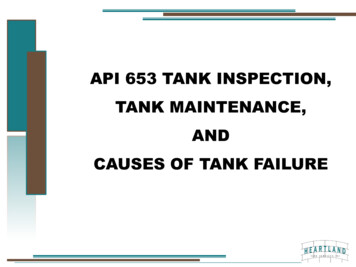
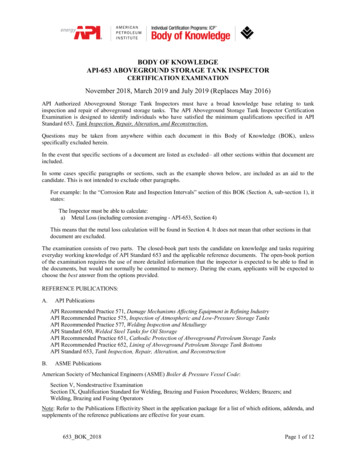
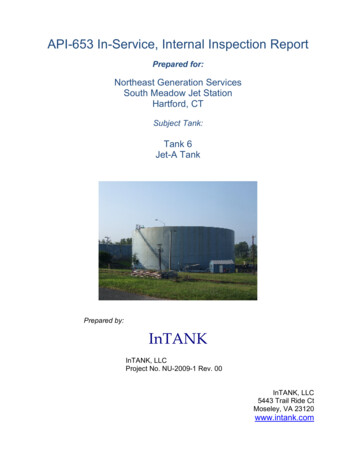
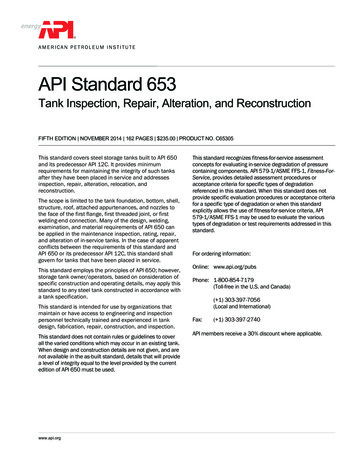
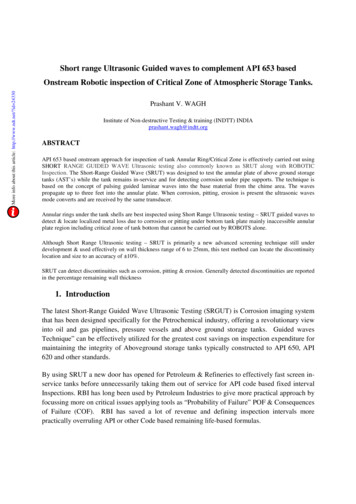
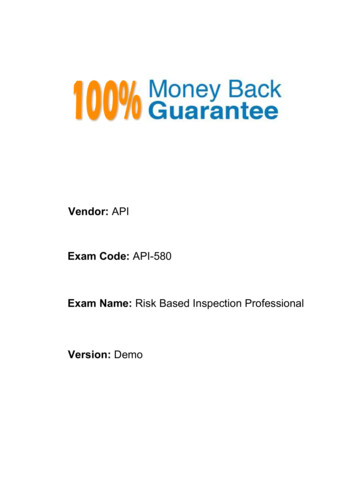
![API Ballot: [Ballot ID] – API 510 & API 570, Deferrals, Rev05](/img/5/api510andapi570deferralsrev5.jpg)
